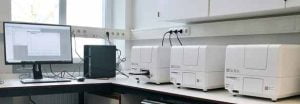Whether replacing animal proteins with plant-based ones, finding and producing of promising probiotic bacterial strains or improving nutrition and health products, at NIZO they know what to do. The CRO with roots in the dairy industry performs increasing increasingly carries out research for companies in the food and beverage, pharmaceutical and health markets.
Distinctive in all this is its expertise in the field of bacteria and fermentation processes. Much of the research therefore begins in the microbiology department. Fermentation Scientist Patrick Janssen works there on bacterial strain screening and medium optimization.
Uniformity in readers
 Both absorption and fluorescence are read out on microplate readers, in the case of NIZO the multi-mode readers from Agilent-Biotek. “At the end of last year we purchased four Synergy H1 readers in order to get as much uniformity get uniformity within the devices.
Both absorption and fluorescence are read out on microplate readers, in the case of NIZO the multi-mode readers from Agilent-Biotek. “At the end of last year we purchased four Synergy H1 readers in order to get as much uniformity get uniformity within the devices.
As a result, when running projects multiple options. For example, we have labs where we work with genetically modified organisms; other labs are equipped for food-grade organisms. It is desirable because of quality and efficiency not to have to lug readers between these labs. Sometimes we have incubations of three weeks; then you shouldn’t have to wait until that experiment is finished before you can start a new one. And also very practical: if you want to run several experiments at the same time at different temperatures, then you also have multiple devices in use.
With four devices, working exactly the same way, you have optimal flexibility and the required capacity. Also we can easily share protocols between the different readers.
For us, it is essential that they do their job reliably and do exactly what they are supposed to do.
Using the intuitive operating software you can indicate that clearly, where there are also many options to configure a protocol to your own needs. We have basically default settings for the wavelength at which we measure. But because we perform research for a wide variety of customers, we want to have the flexibility to be able to adjust that. If you need to measure a particular enzyme at a certain wavelength, you should be able to do that. The freely adjustable range gives us the required flexibility.”